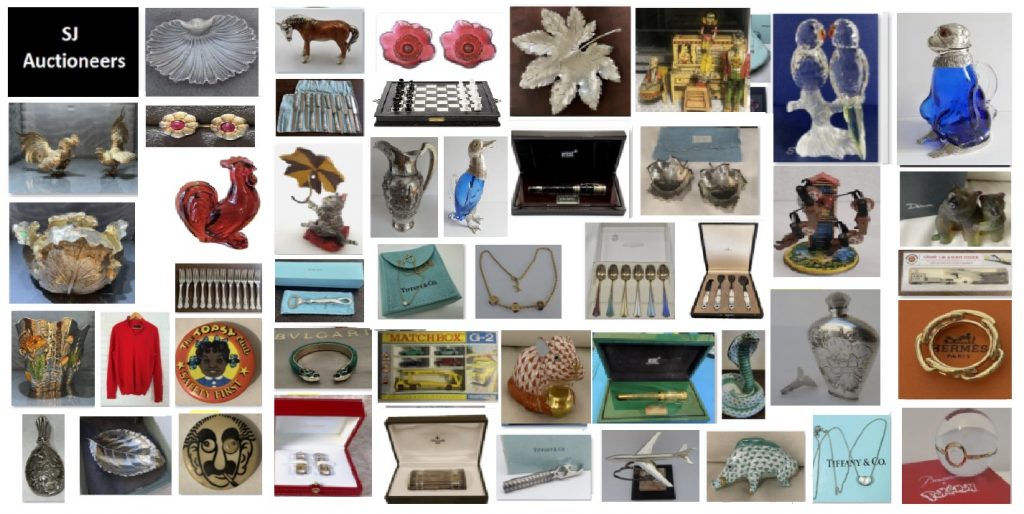Over 220 Lots Feature Fine Jewelry, Designer Scarves, Couture Clothing & More
SOUTH SAN FRANCISCO, CA, November 19, 2025 – Turner Auctions + Appraisals is pleased to present the Winter Auction of Jewelry & Treasures on Saturday, December 13, 2025, at 10:30 am PST. Featuring over 220 lots from several estates for special gifts to give others or oneself, offerings include gem-set jewelry; unmounted stones; couture clothing; luxury-brand scarves, purses and bags; several fur coats; a vintage wedding dress; fine pens; and more.
Jewelry lots include necklaces, rings, bracelets, pendants, brooches, earrings and ear clips, charms, stick pins, watches, a scarf ring, and a chatelaine. Most are gold or silver, including sterling or blackened; most are set with gemstones such as diamond, emerald, ruby, amethyst, pearl, sapphire, opal, garnet, jade, aquamarine, citrine, turquoise, topaz, tourmaline, coral, moonstone, and/or malachite – plus cameos and intaglios, pietra dura, and shakudo. Some pieces are antique or vintage. Note jewelry designers include Tiffany, Hermès, John Hardy, Sergio Bustamente, Kieselstein-Cord, Erté, Angela Cummings, and Charles Garnier. There are also groupings and sets of antique, vintage and costume jewelry. Among the watch makers are Girard-Perregaux, Porsche, Movado, and Rado. The wide selection of unmounted stones includes sapphire, opal, topaz, ruby, tourmaline, benitoite, spessartite, alexandrite, cat’s eyes, and other gemstones.
There is an extensive array of luxury fashion items for women. Evening gowns, dresses, and skirts are from Valentino, Arnold Scaasi, Monique Lhuillier, and Pamela Dennis. Purses, bags, totes and luggage lots are from Chanel, Louis Vuitton, Bottega Veneta, Gucci, Kate Spade, and Prada. Scarves feature designs by Chanel, Gucci, Cartier, Louis Vuitton, Tiffany, Fendi, Burberry, Ferragamo, Yves St. Laurent, Longchamps, and Ralph Lauren. Several fur coats, pens, scent bottles, and a vintage wedding dress complete the sale.
Turner Auctions + Appraisals begins its online auction on Saturday, December 13, 2025, at 10:30 am PST; sale items are available for preview and bidding now. The auction will be featured live on four platforms: LiveAuctioneers, Invaluable, Bidsquare, and Turner Auctions + Appraisals’ free mobile app, which can be downloaded from the App Store or Google Apps (“Turner Auctions”). Both are easily accessed through ‘Upcoming Auctions’ at the company’s website: www.turnerauctionsonline.com/upcoming-auctions/.
Here below are some highlights of the upcoming online sale (please see lot details in the online catalog):

LOT 105: Art Deco Burmese Ruby and Diamond Ring. The platinum ring centering an oval-shaped unheated Burmese ruby ring measuring approximately 6.80 x 5.70 x 3.74 mm, and weighing an estimate 1.15 carats, flanked by two European-cut diamonds weighing together an estimated 1.60 carats, and further set with round and single-cut diamonds; estimated total diamond weight for the ring: 2.30 carats; weighing approximately 5.24 grams; size: 7. Accompanied by AGL report #1151101, dated October 3, 2025, stating: Natural Corundum, Ruby, Origin Burma, No gemological evidence of heat. Estimate $4,500-$6,500.
LOT 38: Erté Diamond, 18k Gold ‘Les Etoiles State Ll’ Necklace. Circa 1988, limited edition no. 7 of 9, with 48 round brilliant-cut diamonds weighing in total approximately 0.50 carat; signed Erté, Seven Arts Ltd 7/9, CPA 18k; weighing approximately 34.38 grams; length: 18 1/2 in. Accompanied by Erté Fine Art Jewelry Certification. Estimate $2,00-$3,000.
LOT 28: A Pair of Emerald, Diamond, 14k Gold Tassel Earrings. Designed with numerous emerald bead tassels, the gold caps set with round brilliant-cut diamonds; total emerald weighing approximately 66.85 carats; total diamond weight approximately: 1.55 carat; weighing approximately 15.7 grams; length: 3 3/8 in. Estimate $2,500-$3,500.
LOT 53: Tiffany & Co. Sapphire, Diamond and 18k Gold Ring. The 3-stone ring centering a square-cut sapphire weighing approximately 1.50 carats, flanked by two square-cut diamonds, together weighing approximately 0.80 carat; signed Tiffany & Co.; weight 3.65 grams; size: 5 1/2+ (sapphire with heavy abrasion). Estimate $1,500-$2,500.
LOT 20: Tiffany & Co. Germany 18k Gold Necklace. Of knot motif; weighing 21.80 grams; length: 29 3/4 in. Estimate $1,000-$1,500.
LOT 25: A 14k Gold Bracelet, Italy. The flexible bracelet, weighing 25.93 grams; length: 7 1/4 in., width: 7/8 in. Estimate $800-$1,200.
LOT 212: Vintage Chanel Black Quilted Caviar Tote. A vintage Chanel black “Caviar” quilted leather tote with gold-toned Chanel stamped hardware and chain/leather woven straps; gilt-stamped leather Chanel label inside. Open top and two compartments with center zip pouch divider. Approx. 9 1/4″ x 13″ x 5″. Very good vintage condition, with light use wear. With dust bag and box. NOTE: Accompanied by a Chanel Internal Repair Form (8/20/15) confirming repair of hole on corner, restitching of lining, and twisted chain. Estimate $800-$1,200.
LOT 152: Unmounted Spessartites. Three oval and one pear-shaped stones, weighing 5.80, 9.61, 12.23 and 18.30 carats. Spessartite is a vibrant orange-to-red gemstone from the garnet group. Estimate $800-$1,200.
LOT 85: Girard-Perregaux 18k Gold Wristwatch. Ladies wristwatch; gross weight: 27 grams; 15mm diameter; overall length: 7 1/8in. Estimate $400-$500.
LOT 204: Vintage Bottega Veneta Black Suede Tote. The vintage black suede large tote bag with woven leather handle, with interior gold-toned metal label: Bottega Veneta / Made in Italy (paper Bottega Veneta label inside zipper pocket). Approx. 15 1/2″ x 13″ x 15 1/2.” Very good vintage condition: clean interior. Estimate $300-$500.
LOT 174: Gucci Silk Scarf, Fox in Fall Foliage. A vintage Gucci, Italy silk scarf, a fox in fall forest foliage on dark blue ground. Edges hand-rolled to back. Approx. 34″ square. Excellent vintage condition. Estimate $100-$200.
LOT 207: Vintage Gucci Dionysus Suede Shoulder Bag. The brown suede shoulder bag with enameled silver metal tiger head hardware on the flap-band snap closure; metal brackets at sides; the interior stamped “Made in Italy by Gucci / Brev. N. 36277.” Approx. 8 1/2″ x 10″ x 3.” Very good vintage condition; light wear; light soiling to interior. Estimate $300-$500.
LOT 218: Arnold Scaasi Couture Ice Blue Pleated Ball Gown (Size 10), with Wrap. Circa 1980s. A Scaasi Boutique labeled custom strapless ball gown of ice blue taffeta pleated at the bodice, three pleated tiers to the full skirt over an integral silk and tulle petticoat; together with a matching wrap (tied as sash for display). The special order tag inside the skirt identifies the style(?) as “Antonia.” Labeled Size 10 (US). Approx. flat measurements: chest 16″; waist 15″; length from back of bodice 49″. Very good to excellent vintage condition; however, sticky strips on its long-term storage hanger led to some brownish spots of staining to the inside/top of bodice, faint staining and very tiny speckles to top/sides of bodice, as well as staining to the wrap. Estimate $150-$250.
LOT 144: An Unmounted Black Opal. The pear-shaped opal weighing 11.88 carats. Estimate $300-$500.
###
ABOUT TURNER AUCTIONS + APPRAISALS
Based in South San Francisco, Turner Auctions + Appraisals was founded by Stephen Turner to expand and complement the capabilities of Stephen G. Turner Associates, an auction and appraisal consulting firm founded in 2004. Turner Auctions + Appraisals presents online auctions in diverse categories of personal property (www.turnerauctionsonline.com). Among them are Fine Arts, Decorative Arts, Asian Arts, Toys, Jewelry, Militaria, Ethnic Arts, and others. The company offers a range of auction and appraisal services for buyers, sellers, and collectors. Online auctions are held several times a month. Working with leading live and online auction houses on the West Coast since 1991, Turner is a professional appraiser of personal property and seasoned auctioneer. His areas of expertise include fine art, decorative arts, antiques & residential contents. The company welcomes consignments and appraisals.
For more information about the company, please contact:
Stephen Turner, President
Turner Auctions + Appraisals, 461 Littlefield Avenue, South San Francisco, CA 94080
415-964-5250 / [email protected] / www.turnerauctionsonline.com
For media inquiries or photos, please contact: Jill Turner, Rodin & Shelley Associates / [email protected]






















